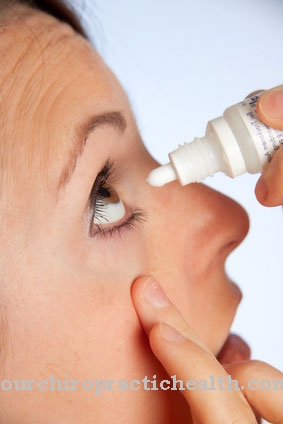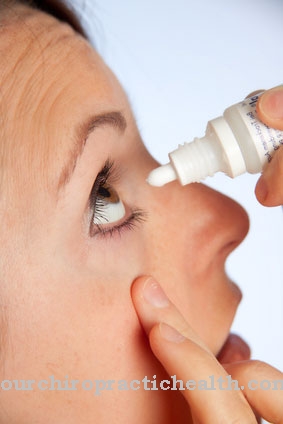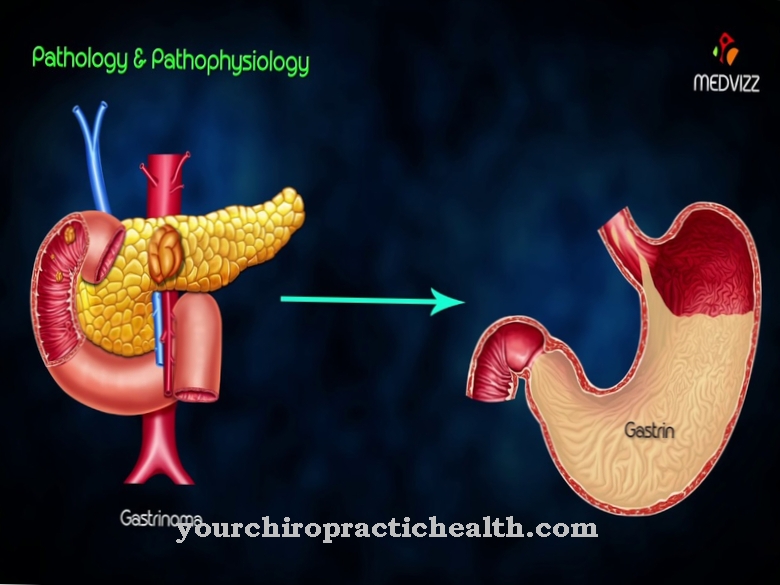The Stevens Johnson Syndrome is a serious skin disease that can develop as an allergic immunological reaction to various drugs, infections and malignant processes. Skin symptoms like cockades form not only on the skin, but also on the patient's mucous membrane. Treatment eliminates the primary cause of the reactions as much as possible.
What is Stevens-Johnson Syndrome?

© lizaelesina - stock.adobe.com
Skin diseases can be congenital or acquired. One form of acquired skin disease is skin lesions in response to infection, drugs, or other toxins.The erythema exudativum multiforme occurs, for example, in the upper corium and corresponds to an acute dermal reaction to inflammation. It is an erythema, i.e. reddening of the skin in the context of infections with herpes simplex, streptococci or paraneoplasias.
Medicines can also be responsible for the erythema. The Stevens Johnson Syndrome is a form of erythema exudativum multiforme and accordingly belongs to the more serious allergic drug or infection reactions of the skin. The term used to be used for the allergic reaction Erythema exudativum multiforme majus used.
In the meantime, however, this use of the term has become obsolete, as there are different etiologies for the two skin reactions. Stevens and Johnson are considered to be the first to describe Stevens-Johnson Syndrome and gave the symptom complex its name.
causes
In about half of all cases, the cause of Stevens-Johnson syndrome is an allergic reaction to certain drugs. In most cases, sulfonamides, codeine or hydantoins are responsible for the dermal reaction.
In addition, a causal link between Stevens-Johnson syndrome and NSAIDs, NNRTIs, allopurinol, moxifloxacin and strontium ranelate was established. The allergic reaction is an immunologically induced, T-cell-mediated necrosis of keratinocytes. However, the exact pathogenesis remains unclear.
Stevens-Johnson syndrome does not necessarily have to be related to drug allergies. More rare, but theoretically conceivable triggers of the immune reaction are malignant processes such as lymphomas. In addition, cases of Stevens-Johnson syndrome have been reported against the background of mycoplasma infections and other bacterial or viral infections.
Symptoms, ailments & signs
Clinically, Stevens-Johnson syndrome manifests itself in severe general symptoms at the acute onset. The general well-being of the patient deteriorates suddenly and often leads to high fever and rhinitis. In almost all cases, the mucous membranes are heavily involved in the reaction.
On the skin and mucous membrane, erythema with a blurred border and a dark central color develop in a very short time. This characteristic symptom is also referred to as atypical cockades. Blisters appear in the mouth, throat and genital area. The skin changes are often painful or otherwise sensitive to touch. The skin of the eyes is usually not spared from symptoms either.
In many cases, erosive conjunctivitis occurs. In most cases, patients can no longer open their mouths. This leads to difficulties in eating. In the course of the rather severe skin reaction, complications can arise. The maximum complication is Lyell's syndrome, also known as scalded skin syndrome.
Diagnosis & course of disease
Although Stevens-Johnson syndrome usually shows typical symptoms, a skin biopsy is usually performed as part of the diagnosis. The tissue sample is used to confirm or rule out a suspected diagnosis of Stevens-Johnson syndrome. Specific laboratory parameters or special tests are not available for diagnostics.
However, necrotic keratinocytes are typically found in histopathology. Vacuolization of the basement membrane is just as significant. Subepidermal cleft formation can also speak for Stevens-Johnson syndrome. The prognosis for patients with the syndrome is rather poor compared to most other skin reactions.
The lethality is around six percent. If the syndrome develops into Lyell's syndrome, the mortality rate is even around 25 percent. In less severe cases, the skin symptoms heal without leaving scars. At most, skin pigment disorders remain. Due to mucosal strictures or adhesions, however, the risk of complications is high.
Complications
Stevens-Johnson syndrome can be very difficult. The ulcers leave scars as they heal. Mucosal shrinkage can also occur. Since the mucous membranes are very irritated in the acute phase of the disease, there is a risk of a second infection with local pathogens such as fungi or bacteria.
Furthermore, it can lead to severe fluid loss and as a result dehydration and physical or mental deficits. If the inflammation spreads to the skin of the eyes, this can result in conjunctivitis. A serious complication is Lyell's syndrome, in the course of which the skin peels off and becomes necrotic.
In one out of four cases the secondary symptom ends fatally. In less severe cases, skin pigment disorders remain. Further complications can arise from adhesions and changes in the structure of the mucous membrane. The treatment of Stevens-Johnson syndrome involves various risks - for example with preparations such as macrolide antibiotics and tetracyclines.
Both agents can cause side effects and interactions, and occasionally allergic reactions occur. Intensive care measures such as infusions can lead to infections or injuries. Serious complications such as blood clots or tissue necrosis cannot be ruled out as a result of improper treatment.
When should you go to the doctor?
In Stevens-Johnson syndrome, the person concerned has to see a doctor. Since it cannot heal itself independently and the symptoms of the syndrome usually worsen if left untreated, a doctor should be consulted as soon as the first symptoms indicate the syndrome.
Only through early detection and treatment of this disease can further complications be prevented. In case of Stevens-Johnson syndrome, a doctor should be consulted if the person concerned has a very high fever. The fever usually occurs suddenly and does not go away on its own. Blisters form in the mouth and throat, and most people also have conjunctivitis. If these symptoms occur, the person concerned must contact a doctor immediately.
Stevens-Johnson syndrome is usually treated in a hospital. An emergency doctor should be called in emergencies or if the symptoms are very pronounced. Whether the disease can be completely cured cannot generally be predicted.
Treatment & Therapy
Various methods can be used to treat patients with Stevens-Johnson syndrome. In all cases, the therapeutic measures focus on eliminating the primary cause of the reaction. The cause usually lies in medication that has been given over the past few weeks. The medication should be discontinued or replaced promptly.
Mycoplasma infections must also be viewed in a causal relationship with the syndrome. Such infections are treated with tetracyclines or macrolide antibiotics. Antibiotics are preferable in the case of infected children. Glucocorticoids are controversial in their effectiveness in the context of Stevens-Johnson syndrome and are not given due to the increased mortality rate.
According to recent studies, patients with mouth and throat symptoms in particular suffer more easily from infections of the respiratory tract as part of corticosteroid treatment. In addition to corticosteroid administration, immunoglobulin administration is also dangerous. Large-scale detachments of the skin are treated according to the therapy rules for burn patients.
The most important steps in this context include intensive medical measures for fluid balancing, protein balancing and electrolyte balancing. In addition, permanent cardiovascular monitoring is indicated for severe cases. The same applies to infection prophylaxis. If the patient's food intake is disturbed because of the lesions, parenteral nutrition is given. Disinfecting solutions and moist compresses are indicated for local therapy.
You can find your medication here
➔ Medicines against redness and eczemaprevention
Stevens-Johnson syndrome is an allergic immunological reaction. The infection-associated form of the skin disease can be prevented by general infection prophylaxis. Since the syndrome can also develop on the basis of drug allergies or malignant processes, there are hardly any comprehensive preventive measures available.
Aftercare
Stevens-Johnson syndrome requires extensive follow-up care. The skin disease can cause a variety of symptoms that may persist for some time after the cause has been treated. The dermatologist can examine the abnormal areas and prescribe suitable medication and measures.
With early treatment, the Stevens-Johnson syndrome should resolve quickly. You can consult your doctor again after a few weeks. As part of the aftercare, it is checked whether the prescribed medication is working. If a drug has been discontinued, it is checked whether the drug was actually the cause of the symptoms.
If necessary, several tests must be carried out for this until the desired result is achieved. Follow-up care can accordingly extend over weeks or even months. As a rule, however, dermatostomatitis can be treated well without any subsequent symptoms being expected. Follow-up care for Stevens-Johnson syndrome is provided by the family doctor.
Depending on the severity of the disease, different specialists can be involved in the therapy. In addition to the dermatologist, internists may also be responsible for treatment and aftercare. After the local therapy, the treated areas must be checked for swelling or abnormalities. If complications arise, the therapy must be adjusted.
You can do that yourself
Self-help is not advisable for Stevens-Johnson syndrome. Rather, patients should consult a doctor immediately. There may be life-threatening conditions. The following self-help measures are therefore only intended as supplementary self-therapy.
Since it is an allergic reaction, general infection prophylaxis sometimes promise relief. However, not all possible causes can be excluded. In three-quarters of all cases, drugs trigger Stevens-Johnson syndrome. A withdrawal inhibits the typical symptoms, but can lead to other problems. Those affected should therefore first consult their doctor before giving up drugs.
With many illnesses such as Stevens-Johnson Syndrome, rest and protection are the best path to recovery. Doctors also recommend moist compresses that you can put on yourself without much effort. These should be provided with a chamomile extract. Corresponding hip baths for the genital area are also available in drugstores. There are rinses with chamomile for the mouth area. Rashes are characteristic of Stevens-Johnson syndrome. Ointments with a high zinc content help to reduce the reddening. These are also available for free and without a prescription.






.jpg)


















.jpg)


